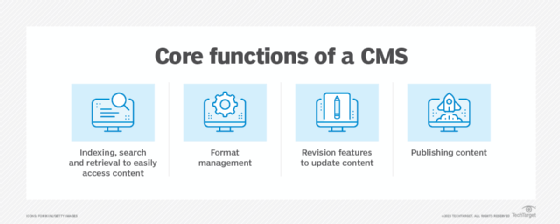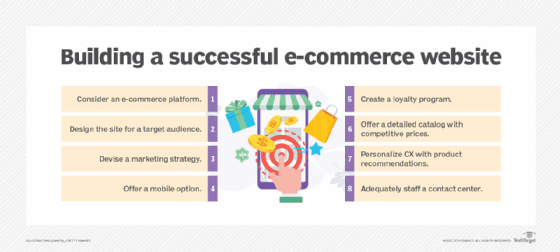To gain substantial value from an online store, organizations should pair their content management systems and e-commerce platforms.
Together, a CMS and e-commerce platforms can provide valuable information for customers and help convert casual browsers into buyers. This integration can also help organizations better manage and organize their content and product information. Explore what CMSes and e-commerce platforms are, key differences between them and how they can work together.
A CMS manages content through its lifecycle. Content creators can author, store, edit, publish and archive content using CMS workflows. These workflows can streamline processes, aid in search and discovery on a brand's website, and employ search engine optimization (SEO) to improve placement on external search engines.
To aid authors working within a CMS, IT teams can configure templates, deploy SEO tools or tagging schemas, connect or integrate media management tools, or use API technologies to integrate the CMS with other systems. IT teams can configure a CMS to support many different use cases, like content marketing, knowledge bases, or simple marketing or presales information websites.
While many commercial CMSes are available, some of the most powerful platforms are open source, including WordPress, Drupal and Joomla. Organizations can often implement these systems for free, but many key plugins or features may have associated licensing fees.

E-commerce platforms facilitate customer engagement and ordering. They have features to list products, provide online shopping carts, integrate with payment processors and enable fulfillment. Many e-commerce platforms also offer inventory management features to avoid frustrating customers with out-of-stock products. These features also alert the seller's personnel to restock.
A company with e-commerce applications generally has a product or service it can sell online. Over the years, many industries have been disrupted when entrepreneurs realized offline transactions could also be e-commerce transactions. The range of these disruptions includes the hotel industry with companies like Airbnb and Vrbo and the taxi industry with companies like Uber and Lyft.

Key differences between CMS and e-commerce platforms include the following.
The purpose of a CMS is to manage content through its lifecycle, while the purpose of an e-commerce platform is to manage the sales and delivery process. Many CMS users are interested in content, with no direct connection to sales, while many users of e-commerce platforms might only need limited product information in their e-commerce platform to handle sales and have no need for a full CMS.
CMSes and e-commerce systems both have back-end and front-end users. Back-end CMS users create and manage content, while back-end users of an e-commerce platform create and manage a shop, its products, product availability, pricing and fulfillment logistics. Front-end CMS users and e-commerce systems also differ. While front-end CMS users look for content, front-end users of an e-commerce site look to shop or manage their purchases.
SEO is tailor-made for CMSes, where content can have keywords relevant to search. CMSes also often have a workflow that includes creation, editing and publication, enabling program management and quality control. E-commerce platforms control product information specifically, and their workflows are often weak or simple. Their strength is in the shopping cart, payment processing and order fulfillment.
The architectures of CMSes and e-commerce systems often differ. E-commerce systems maintain transaction security and scaling during a sales spike. They tend to limit the availability of APIs to minimize the attack surface. CMSes are more often open source and flexible, with numerous plugins and available APIs.
Both CMSes and e-commerce platforms have search optimization features, but their focuses differ. A CMS focuses on content discoverability and ways to improve the relevance of content so it can move up in search engine rankings. E-commerce platforms focus on sales, so SEO centers on product search and then on conversion and upselling once a potential customer visits the site.
An integration of CMS and e-commerce can improve an organization's ability to sell online and provide key content to sellers within the integrated site. A CMS can publish content marketing articles that bring people to the site, while the e-commerce functions offer access to shopping for related products. Often, the e-commerce platform runs the website and brings in content from a headless CMS, which does not display content directly but serves as a repository for API access by the e-commerce platform.
Alternately, some CMSes offer e-commerce plugins, such as WordPress with a Shopify plugin or Contentful with BigCommerce. Organizations that want to combine the capabilities of CMS and e-commerce platforms should consider the desired customer experience they want to create. The sweet spot is where content drives sales or where casual customers become interested in the content, which brings them back to the store and turns them into repeat customers.
Jordan Jones is a writer versed in enterprise content management, component content management, web content management and video-on-demand technologies.










